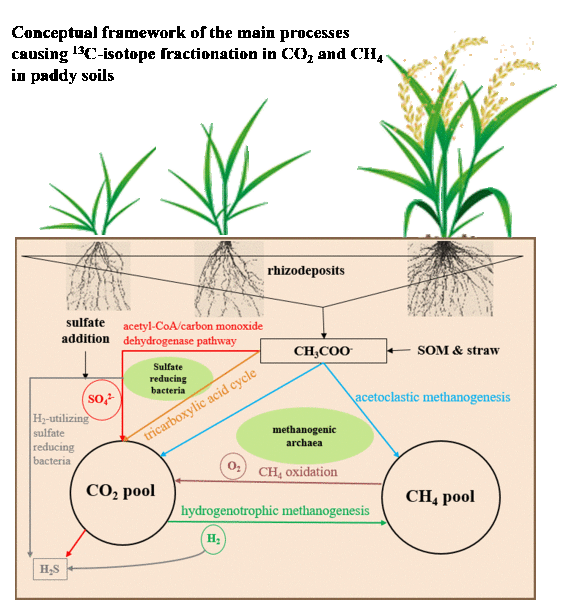Alternate wet-drying rather than sulfate fertilization controlled pathways of methanogenesis and methane turnover in a rice-straw-amended paddy soil
O 1.2 in Session 1: Soil Secrets Revealed
29.10.2020, 09:30-09:45, online via Zoom
Methane (CH4) emissions from paddy soils are mediated by microbial-driven processes, which are highly dependent on crop and field management. Alternate wet-drying (WD) and sulfate fertilization were considered as effective management practices for lowering CH4 emissions from paddy soils. However, the effects of management practices on in situ belowground CH4 turnover (production and oxidation) are not fully understood, yet. Here, soil CO2 and CH4 concentrations and their stable C isotope composition were measured in straw-amended paddy soils with and without sulfate fertilization under continuously flooded conditions and two wet-dry-cycles at three rice growing stages. CH4 concentrations reached up to 51.0 mg C L-1 at flowering stage under fully flooded conditions whereas with WD they dropped below 0.04 mg C L-1. Relative enrichment of δ13C in CH4 and depletion of δ13C in CO2 under WD indicated CH4 oxidation. Sulfate addition had no significant effect on CH4 concentrations. The sufficient substrate supply might have prevented sulfate-reducing bacteria (SRB) from out-competing methanogenic archaea (MA) and therefore explain the lack in decreasing CH4 production. However, it did increase plant height and biomass, and significantly increased dissolved organic carbon concentrations compared with no-sulfate-treatments. Remarkable was an observed significant enrichment of δ13C-CO2 over time (from -21.7‰ to -14.4‰ and -18.4‰ to -13.3‰ with and without sulfate fertilizer, respectively) under flooded conditions. This likely indicated the increasing contribution of hydrogenotrophic methanogenesis to CH4 production with ongoing rice growth. Interestingly, sulfate fertilization caused pronounced depletion of δ13C-CH4 for all rice growth stages and both water regimes, which implied a shift in methanogenesis pathways. Overall, the results show that WD can more efficiently reduce CH4 production than sulfate fertilization in rice-straw-amended paddy soils.

Conceptual framework of the main processes causing 13C-isotope fractionation in CO2 and CH4 in paddy soils
Export as iCal:


